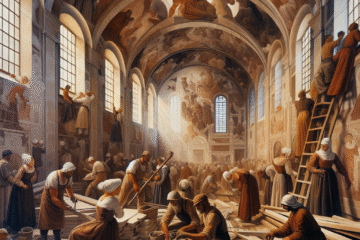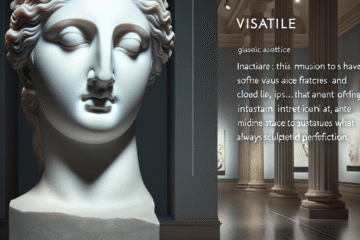I. Introduction
- Definition of Surrealism in art
- Brief overview of the Surrealist movement
Surrealism is a cultural and artistic movement that originated in the early 1920s. It is characterized by the use of irrational and dreamlike elements, as well as a focus on the unconscious mind and the role of the imagination in art. Surrealist artists sought to challenge traditional modes of representation and subvert the norms of society through their art.
The Surrealist movement was heavily influenced by Freudian psychology and the theories of the unconscious mind. Surrealists believed that the unconscious held a deeper truth and that it could be accessed through dreams, free association, and automatism, a process of creating art without conscious control.
Surrealist art often featured strange and fantastical imagery, such as distorted figures, unexpected juxtapositions, and elements from the natural world. Surrealist artists also made use of techniques such as collage and photomontage to create their works.
The Surrealist movement was not limited to art, but also encompassed literature, film, and politics. Surrealist writers and poets used techniques such as automatic writing to tap into the unconscious, and Surrealist films sought to create dreamlike experiences for the viewer. The Surrealist movement was also politically radical, with many members advocating for social and cultural change.
In conclusion, Surrealism was a revolutionary movement in the art world that sought to explore the unconscious mind and challenge traditional modes of representation. Its influence can still be seen in contemporary art and culture.
II. Origins of Surrealism
- Historical context of Surrealism’s emergence
- Influences on the Surrealist movement (e.g. Dadaism, Freudian psychology)
The Surrealist movement emerged in the aftermath of World War I, a time of great social and political upheaval. Many artists and intellectuals were disillusioned with the traditional values and structures of society and sought to challenge them through their work.
One key influence on Surrealism was the Dada movement, which emerged in the years leading up to World War I as a reaction to the perceived absurdity of the war and the society that had allowed it to happen. Dadaists rejected traditional art forms and embraced chaos and irrationality as a means of subversion.
Another major influence on Surrealism was the work of Sigmund Freud and his theories of the unconscious mind. Freud’s ideas about the role of the unconscious in shaping human behavior and thought resonated with the Surrealists, who sought to tap into the unconscious as a source of creativity and truth.
The Surrealist movement was officially launched in 1924, when the French poet André Breton published the Surrealist Manifesto. In this document, Breton outlined the principles of Surrealism and declared that the movement’s goal was to overthrow the oppressive rationalism of the modern world and embrace the irrational.
The Surrealist movement was comprised of artists, writers, and intellectuals from various countries, including France, Belgium, Spain, and the United States. It was active throughout the 1920s and 1930s, and its influence can still be seen in contemporary art and culture.
III. Characteristics of Surrealist Art
- Use of irrational and dreamlike elements
- Exploration of the unconscious mind
- The role of automatism in Surrealist art-making
One of the defining characteristics of Surrealist art is the use of irrational and dreamlike elements. Surrealist artists sought to challenge traditional modes of representation and instead embraced the strange and fantastical. This often involved the use of distorted figures, unexpected juxtapositions, and elements from the natural world.
Surrealist art also explored the unconscious mind and the role of the imagination in art-making. The Surrealists believed that the unconscious held a deeper truth and that it could be accessed through dreams, free association, and automatism. Automatism is the process of creating art without conscious control, allowing the unconscious to take over and guide the creation of the work.
One technique used by Surrealist artists to tap into the unconscious was the technique of frottage, in which an artist would place a piece of paper over a textured surface and rub a pencil over it, creating an abstract image. This process was believed to allow the unconscious to take over and create a unique image that couldn’t be produced through conscious effort.
Surrealist art often featured strange and fantastical imagery that seemed to defy logic, creating a sense of disorientation and dreamlike quality. By challenging traditional modes of representation and embracing the irrational, Surrealist artists sought to subvert the norms of society and encourage viewers to think outside the box.
IV. Surrealist Artists and their Work
- Examples of notable Surrealist artists and their signature styles
- Analysis of specific Surrealist artworks and their symbolism
There were many notable Surrealist artists who made significant contributions to the movement and left a lasting impact on the art world. Some of the most famous Surrealist artists include Salvador Dali, René Magritte, and Frida Kahlo.
Salvador Dali was a Spanish artist known for his highly imaginative and often surreal paintings. He is perhaps most famous for his work “The Persistence of Memory,” which features melting clocks and other dreamlike elements. Dali was also known for his surrealist sculptures and his contributions to Surrealist film.
René Magritte was a Belgian artist known for his surrealist paintings that featured unexpected juxtapositions and play on words. One of his most famous works is “The Treachery of Images,” which features a painting of a pipe with the phrase “Ceci n’est pas une pipe” (This is not a pipe) written beneath it. This painting is a commentary on the relationship between representation and reality and the role of the viewer in interpreting art.
Frida Kahlo was a Mexican artist known for her surrealist self-portraits that explored themes of identity, gender, and politics. Kahlo’s paintings often featured dreamlike elements and symbolized her personal experiences and struggles.
One Surrealist artwork that is particularly notable is Dali’s “The Persistence of Memory.” This painting features melting clocks, which are a symbol of the passage of time and the impermanence of life. The melting clocks are also a play on the idea of the persistence of memory, as memories are often associated with the passing of time. The painting also features other dreamlike elements, such as a distorted landscape and strange creatures, adding to the surreal and disorienting atmosphere of the work.
In conclusion, Surrealist artists were known for their imaginative and often surreal works that explored the unconscious mind and challenged traditional modes of representation. Their signature styles and specific artworks continue to be highly influential and relevant in the art world today.
V. The Impact of Surrealism
- The influence of Surrealism on the art world and beyond
- The ongoing legacy of Surrealism in contemporary art
The Surrealist movement had a significant impact on the art world and beyond during the 1920s and 1930s, and its influence can still be seen in contemporary art and culture.
One of the main ways that Surrealism influenced the art world was through its embrace of irrationality and the unconscious. The Surrealists challenged traditional modes of representation and instead sought to tap into the imagination and the unconscious as a source of creativity and truth. This approach to art-making was revolutionary at the time and helped to pave the way for future movements such as Abstract Expressionism.
Surrealism also had an impact on literature and film. Surrealist writers used techniques such as automatic writing to tap into the unconscious, and Surrealist films sought to create dreamlike experiences for the viewer. The Surrealist movement was also politically radical, with many members advocating for social and cultural change.
The legacy of Surrealism can still be seen in contemporary art, where many artists continue to be inspired by the movement’s embrace of the irrational and the unconscious. The use of dreamlike imagery and the exploration of the unconscious mind are still common themes in contemporary art.
In conclusion, the Surrealist movement had a significant impact on the art world and beyond, and its legacy can still be seen in contemporary art. Its embrace of the irrational and the unconscious continues to inspire and influence artists today.
VI. Conclusion
- Recap of the key points of the article
- Reflection on the enduring significance of Surrealism in art history.
In conclusion, Surrealism was a cultural and artistic movement that emerged in the early 1920s and was characterized by the use of irrational and dreamlike elements, as well as a focus on the unconscious mind and the role of the imagination in art-making. The Surrealist movement was influenced by Dadaism and the theories of Sigmund Freud, and its goal was to overthrow the oppressive rationalism of the modern world and embrace the irrational.
Notable Surrealist artists included Salvador Dali, René Magritte, and Frida Kahlo, and their works continue to be highly influential in the art world today. The Surrealist movement had a significant impact on the art world and beyond, influencing literature, film, and politics, and its legacy can still be seen in contemporary art.
The enduring significance of Surrealism lies in its challenge to traditional modes of representation and its embrace of the irrational and the unconscious. The movement’s exploration of the unconscious mind and the role of the imagination in art-making continues to inspire and influence artists today.


